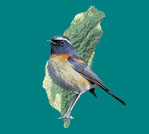|
Malayan Night-Heron
Gorsachius melanolophus
_small.JPG) Malayan
Night-Heron is a medium-sized heron, about 47 cm in length. The crown is
black, with black crest extending to the nape. The upperparts are dark
reddish-brown with fine streaks. The eye ring is light blue. Wings are
black, fading outward to reddish-brown. Primary feather tips are white.
The face is reddish-brown; the chin and upper breast are paler. The
yellowish-brown breast has a central row of black streaks. Malayan
Night-Heron is a medium-sized heron, about 47 cm in length. The crown is
black, with black crest extending to the nape. The upperparts are dark
reddish-brown with fine streaks. The eye ring is light blue. Wings are
black, fading outward to reddish-brown. Primary feather tips are white.
The face is reddish-brown; the chin and upper breast are paler. The
yellowish-brown breast has a central row of black streaks.
The immature
is grayish-brown above with black and white spots; underparts are buff with
brown spots and bars.
The usual
call is: “bo-bo.”
Malayan
Night-Heron is a shy, rare resident of lowland vegetation near water. When
disturbed, it may raise its crest.
 It
is seen comparatively easily in appropriate habitat in middle and southern
Taiwan. It
is seen comparatively easily in appropriate habitat in middle and southern
Taiwan.
Malayan
Night-Heron is also known as Tiger Bittern.
Similar
Species: Japanese Night-Heron lacks a crest, has an olive eye-ring;
primary tips are brown.
Reference: Field Guide: Birds of
Taiwan;
by Wang, J., C. Wu, G. Huang, X. Yang, Z. Cai, M. Cai and Q. Xiao. (1991)
.JPG)
Reproductive Success of the Malayan Night Heron in Central Taiwan
Cheng-te Yao,1 Liang-kong Lin,2
Shao-pin Yo3
1.
Endemic Species Research Institute, COA
2.
Department of Life Science, Tunghai University
3.
Department of Life Science, National Chung Hsing
University
_small.JPG) The
Malayan night heron (Gorsachius melanophus) lives in the lowland
wooded areas in Taiwan. I studied the reproductive success of the Malayan
night heron in the urbanized areas of Tai-chung, Nan-tao, Yun-lin, and Chia-I
Counties, in Central Taiwan. A total of 67 nests of Malayan night heron
were monitored in the breeding seasons of 2000 and 2001. Breeding season
lasted for 210 days in 2000, and 220 days in 2001. Clutch size ranged 2-6
eggs (3.4±0.8, n=67); brood size ranged 0-4 nestlings (2.5±1.5, n=67). The
mean number of young fledged per nest was 1.9±1.5. Incubation period was
30.4±1.2 days, and nestling stage was 36.0±2.1 days. The nesting success
measured by the Mayfield method was 64.44% in 2000, and 61.72% in 2001.
There is no difference between pooled interval success rate of the 1st
nests in the breeding season and that of the 2nd broods. The
pooled interval success rate of the nests of yearlings was 21.11%, whereas
it was 74.27% for the nests of older birds. The mean number of young
fledged per nest was 2.2±1.5 by parents of older birds, while it was only
0.9±1.3 by parents with at least one yearling. Reuses of old nests were
common in Malayan night heron(50%). The breeding success of nests of reused
was 80.29%, while it was 47.18% of nests of only used once. Predation,
starvation, infertile or addled eggs, and inclement weather caused death
were identified to be the major causes of the mortality during incubation
and nestling stages. The main factors that affect the reproductive success
of the Malayan night heron are: the age of the breeding pairs, nest
predation, and reused of old nests. The
Malayan night heron (Gorsachius melanophus) lives in the lowland
wooded areas in Taiwan. I studied the reproductive success of the Malayan
night heron in the urbanized areas of Tai-chung, Nan-tao, Yun-lin, and Chia-I
Counties, in Central Taiwan. A total of 67 nests of Malayan night heron
were monitored in the breeding seasons of 2000 and 2001. Breeding season
lasted for 210 days in 2000, and 220 days in 2001. Clutch size ranged 2-6
eggs (3.4±0.8, n=67); brood size ranged 0-4 nestlings (2.5±1.5, n=67). The
mean number of young fledged per nest was 1.9±1.5. Incubation period was
30.4±1.2 days, and nestling stage was 36.0±2.1 days. The nesting success
measured by the Mayfield method was 64.44% in 2000, and 61.72% in 2001.
There is no difference between pooled interval success rate of the 1st
nests in the breeding season and that of the 2nd broods. The
pooled interval success rate of the nests of yearlings was 21.11%, whereas
it was 74.27% for the nests of older birds. The mean number of young
fledged per nest was 2.2±1.5 by parents of older birds, while it was only
0.9±1.3 by parents with at least one yearling. Reuses of old nests were
common in Malayan night heron(50%). The breeding success of nests of reused
was 80.29%, while it was 47.18% of nests of only used once. Predation,
starvation, infertile or addled eggs, and inclement weather caused death
were identified to be the major causes of the mortality during incubation
and nestling stages. The main factors that affect the reproductive success
of the Malayan night heron are: the age of the breeding pairs, nest
predation, and reused of old nests.
.jpg)
|

